
In the wake of the exclusive Q&A with Danny Ghorbani by MHProNews over the ‘true history’ of the Department of Energy’s (DOE’s) much criticized manufactured housing energy rule and examples of the Manufactured Housing Institute’s (MHI’s) troubling role in that drama, a new and potentially related report from Robert Bryce at Real Clear Energy (RCE) has emerged. By accident or design, the RCE report sheds new light on costly issues that could dramatically cut the production of entry level manufactured homes. That RCE report is published below, courtesy of the WND NewsCenter to MHProNews. While it doesn’t specifically mention manufactured housing, the implications and links with some of the largest forces in our industry – firms connected to Warren Buffett led Berkshire Hathaway (BRK) – are apparent. It will be further outlined in a follow-up below using additional facts, evidence, and expert analysis.
The highlighting below is added by MHProNews for emphasis and to provide readers with a ready look at statements made that are relevant to manufactured housing. The actual text of the report is as provided by WND.
WND MONEY
Wind and solar energy projects now banned in a dozen townships
Decision reflects ‘growing outrage in rural America to corporate land grabs
By WND News Services
Published July 10, 2022 at 12:28pm
[Editor’s note: This story originally was published by Real Clear Energy.]

Real Clear Energy
The backlash against the encroachment of wind and solar projects continues. On June 23, the Butler County (Ohio) Board of Commissioners adopted a measure that designates a “restricted area” that prohibits “the construction of an economically significant wind farm, a large wind farm, and/or a large solar facility.” The measure, which passed unanimously, covers all unincorporated areas within a dozen townships in the county.
The vote is the latest example of local communities rejecting or restricting the growth of large renewable projects. According to an article by Denise G. Callahan, a reporter for the Journal-News, an outlet known as “Butler County’s Local News Now,” the commissioners enacted the measure after hearing from township representatives. Commissioner Cindy Carpenter told Callahan she understands as a public official she has a responsibility to consider ways of reducing reliance on fossil fuels, but she must also be responsive to township officials. Carpenter was quoted in the article as saying “We respect that they are the elected officials closest to the citizens.”
Adding the 12 townships (but not the Butler County commissioners’ vote) to the Renewable Rejection Database brings the total of wind energy rejections so far this year to 20. Since 2013, there have been 344 rejections or restrictions of wind projects across the U.S. in states from Maine to Hawaii.
As I have reported many times, the raging backlash against the renewable industry doesn’t fit the convenient narrative that wind and solar are “green” and that they are “cheaper” than traditional forms of energy production. These rejections are not being covered by The New York Times or National Public Radio, but they reflect the growing outrage in rural American towns and counties over the land grab that is being attempted by some of America’s biggest companies in the name of climate change.
Further, as siting wind and solar projects has gotten more difficult, big renewable companies are resorting to hardball legal tactics to intimidate location communities into accepting projects they do not want. For example, in May, Chicago-based Invenergy, the world’s largest privately held renewable energy company, sued Worth County, Iowa as part of an effort to force the county to accept a wind project the county doesn’t want. That lawsuit came after MidAmerican Energy, a subsidiary of corporate behemoth Berkshire Hathaway, sued Madison County, Iowa, the province known for its picturesque wooden bridges. (Invenergy refused to comment on their lawsuit against Worth County. In an email, a MidAmerican spokesman claimed the company is not trying to intimidate the county.)
Over the past few months, Iowa, Ohio, and Wisconsin have emerged as the epicenter of the rural backlash against Big Wind and, increasingly, Big Solar. Ohio is particularly notable because last year, Senate Bill 52 took effect. That measure allows counties to prohibit the construction of renewable projects. As reported by EnergyWire, “Policy support for renewables has been eroding in Ohio for a decade.” The erosion of support, of course, was due to surging local opposition to renewable projects.
But SB 52 also provides a clear example of the growing urban-rural divide when it comes to renewable energy policy. The bill, which was signed into law by Ohio Gov. Mike DeWine, (a Republican) passed through both chambers of the Ohio legislature but it did not get a single Democratic vote. In addition to giving counties final say over projects, the measure also requires renewable energy developers to go to the Ohio Power Siting Board for approval, a move that may give opponents a second venue in which they can kill proposed projects.
Now back to Butler County. A quick web search located the minutes of the June 23 meeting of the Butler County Board of Commissioners. The minutes show that the measure adopting the “Restricted Area in Butler County” includes “all unincorporated areas within Reily Township, Fairfield Township, Hanover Township, Liberty Township, Madison Township, Milford Township, Morgan Township, Oxford Township, Ross Township, St. Clair Township, Wayne Township, and West Chester Township.”
Butler County is the kind of place that doesn’t get much attention from elite academics, big media outlets, and climate activists. It’s a largely rural county located north of Cincinnati, along Ohio’s border with Indiana. The population of the county is less than 400,000. Butler County has 13 townships. Of those, 12 are included in the ban on new wind and solar.
I’ll conclude with another quote from Callahan’s coverage of the Butler County ban on large renewable projects. She quoted County Commissioner Cindy Carpenter, who said the county agreed to implement the ban because local township officials “speak to us as the voice of the citizens. So I have decided to support their request.”
Robert Bryce is the host of the Power Hungry Podcast, executive producer of the documentary, “Juice: How Electricity Explains the World,” and the author of six books, including most recently, “A Question of Power: Electricity and the Wealth of Nations.” Follow him on Twitter: @pwrhungry.
[Editor’s note: This story originally was published by Real Clear Energy.] ##
Additional Information, More MHProNews Analysis and Commentary in Brief
The RCE report by Bryce, brought to MHProNews’ attention due to our strategic alliance with the WND NewsCenter, is a potential wealth of insights for manufactured housing producers, retailers, communities, and others who are concerned about the potential impact of the DOE’s countdown to enforce their heavy-handed manufactured housing energy rule. Some bullet points below will lay out the matter fairly succinctly.
- Among the reasons that this DOE Energy Rule is still alive is because the Sierra Club, supported per source via dark money channels by Warren Buffett and other left-leaning billionaires, launched a lawsuit. Like the RCE report by Bryce, that Sierra Club suit is evidence of what can ‘work’ with government. Details are in the report linked below.
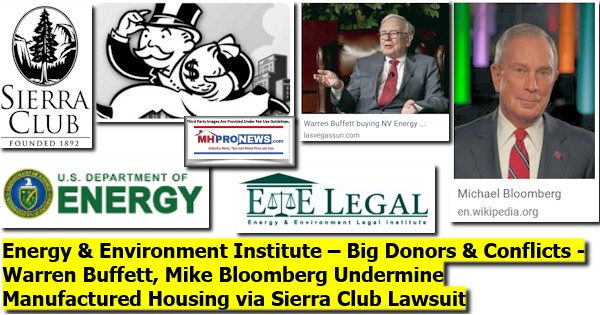
- It seems that the Berkshire-supported Manufactured Housing Institute (MHI) – in their own words (see below) – are doing all sorts of posturing and ‘efforts,’ except litigation to ‘stop’ the enforcement of the DOE Manufactured Housing Energy Rule set to begin in less than 11 months. Yet, it as the exclusive MHProNews report linked above demonstrated, it was litigation by the Buffett ‘Charitable’ Buck$ supported Sierra Club that has caused the industry to face this looming hit on the production of its most affordable manufactured homes. See the report linked below for more. The reasons why Buffett might seemingly be undermining ‘his own industry’ will be explored further below.
- This emerging pattern of Buffett ‘Charitable’ Buck$ supporting Sierra Club is arguably akin to other Buffett ‘Charitable’ Buck$ supporting MHAction (via the Tides nonprofit) on one side of a ‘fight’ against Buffett backed MHI, which clearly draws financial support from numerous Berkshire Hathaway (BRK) brands. Those Berkshire owned firms engaged with MHI include Clayton Homes, 21st Mortgage Corp, community brokers, suppliers, and more. To better grasp in mere minutes the parallel, jump back to the previously posted report on MHLivingNews, linked below.

- Put differently, these are moat tactics deployed by alleged monopolists which stir up headwinds for smaller firms that larger firms can benefit from. It happens to fit the facts laid out by Warren Buffett’s own words, those of his ally billionaire and ‘charitable’ ally, William “Bill” Gates III, and such different sources as Carol Roth or the Job Creators Network (JCN). The later are among those who have declared that there is a war being waged in America against smaller businesses. It also fits the facts of pattern of the tools used by “sabotaging monopolies” described by Minneapolis Federal Reserve Researcher James A. “Jim’ Schmitz, Jr. and his colleagues, or the words of MHI member Andy Gedo at ManageAmerica.


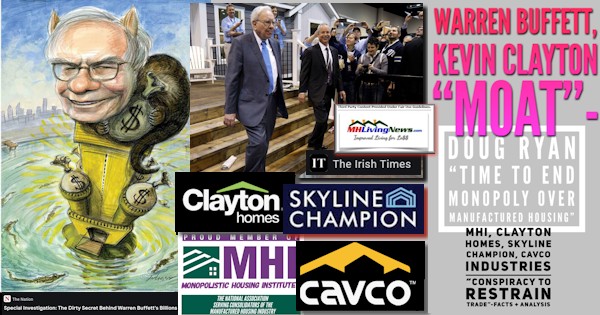

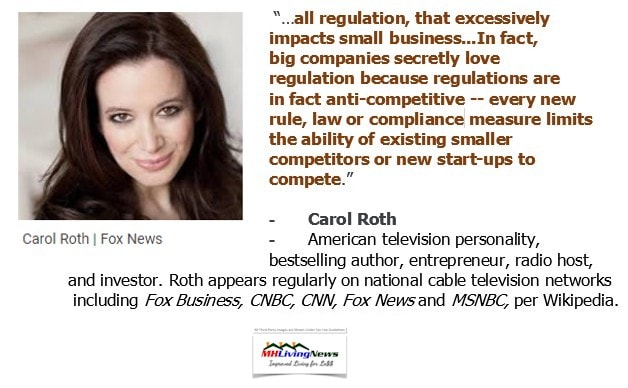



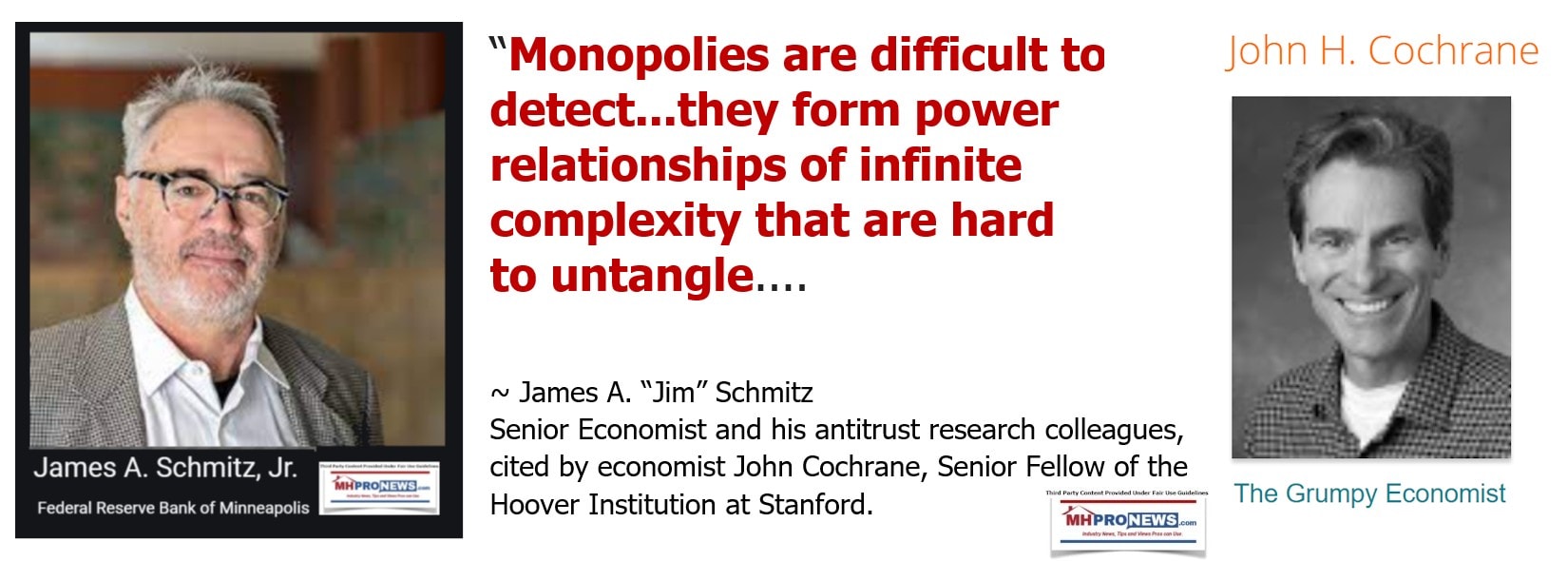
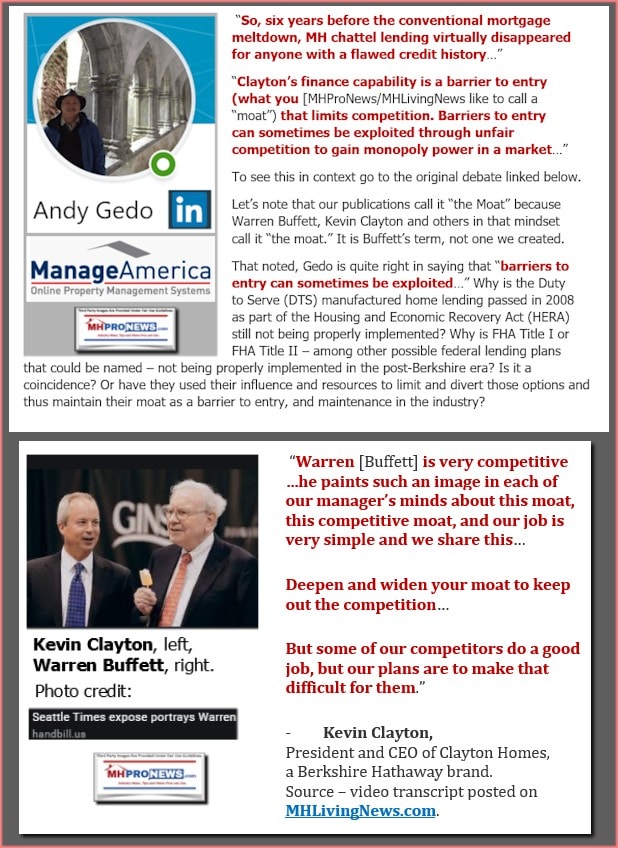
- Perhaps the best hope in the past year for stopping the DOE drive to impose tougher regulations on manufactured housing – regs that MHARR points out are not required by many states for more expensive conventional housing to meet – was the lawsuit, Louisiana vs Biden. That Louisiana vs. Biden suit over the DOE manufactured housing energy rule which was then pending. MHARR, as MHProNews reported, supported that effort, including with an amicus brief to the U.S. Supreme Court (SCOTUS). Note: that effort could be revived, now that the DOE energy rule has been formally promulgated.
MHARR Asserts New Arguments for Withdrawal of Manufactured Housing DOE Energy Rule
MHARR Files Supreme Court Brief to Reinstate Social Cost of Carbon Injunction
Each of these are efforts that arguably fit the claims of Warren Buffett’s son Peter Buffett and those of his longtime ally in business, ‘charitable,’ political and legal maneuverings – Bill Gates. To Stephen Miller’s point, cited above, that the left has ‘perfected lawfare’ – the use of legal action to advance their agendas – keep in mind that Buffett has long aligned with the political left and Democrats. His partner Charlie Munger, J.D., and Berkshire Board member Ron Olson, J.D., have had on their website the following screen capture for some time.
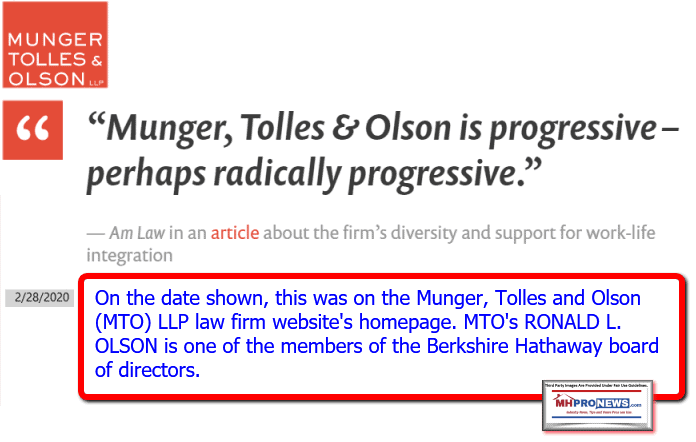
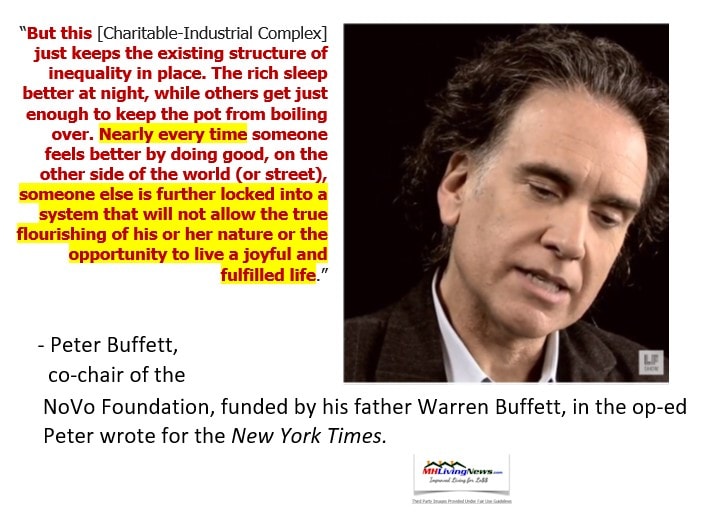
![DidntWantToMeetWarren[Buffett]BecauseGuyBuysSellsFoundImperfectMarketNotValueAddSocietyZeroSumGameParasiticBillGatesPhotoMicrosoftLogoGatesFoundationLogoQuoteQuotableQuoteMHproNews](http://www.manufacturedhomepronews.com/wp-content/uploads/2020/07/DidntWantToMeetWarrenBuffettBecauseGuyBuysSellsFoundImperfectMarketNotValueAddSocietyZeroSumGameParasiticBillGatesPhotoMicrosoftLogoGatesFoundationLogoQuoteQuotableQuoteMHproNews.jpg)
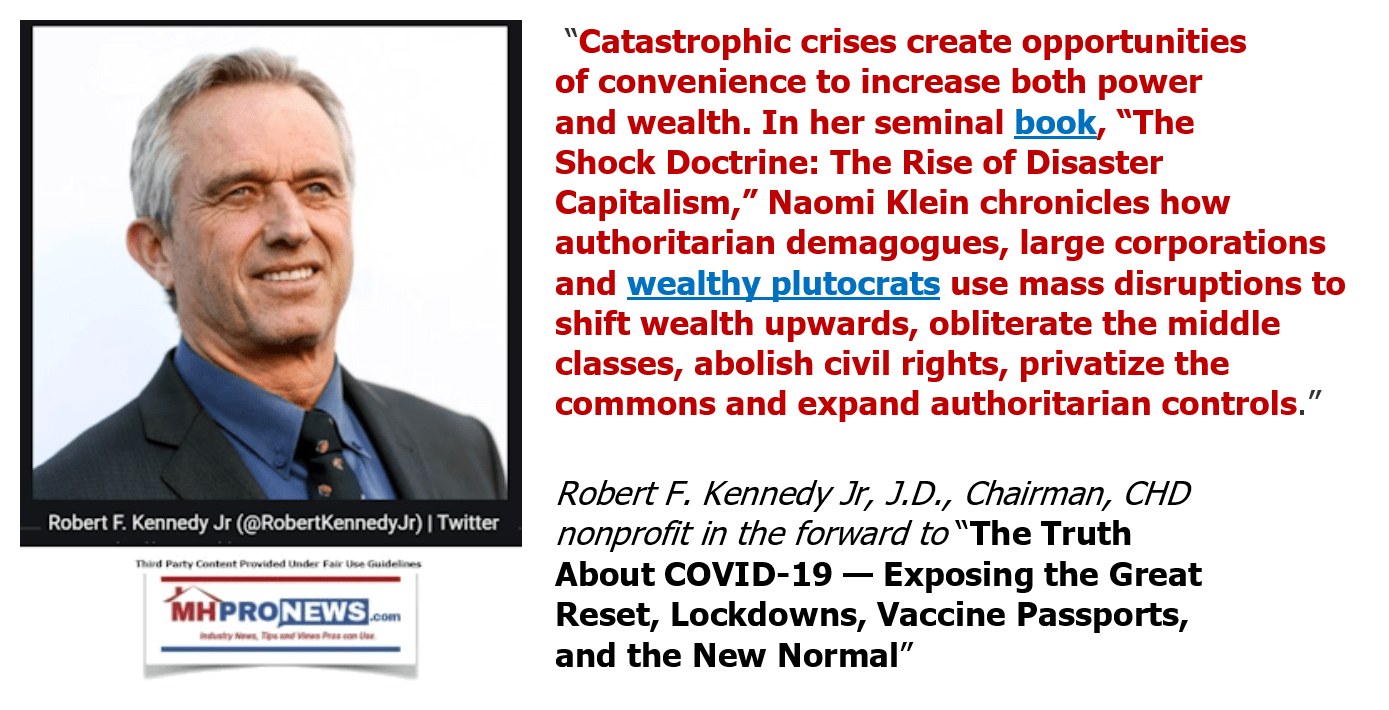
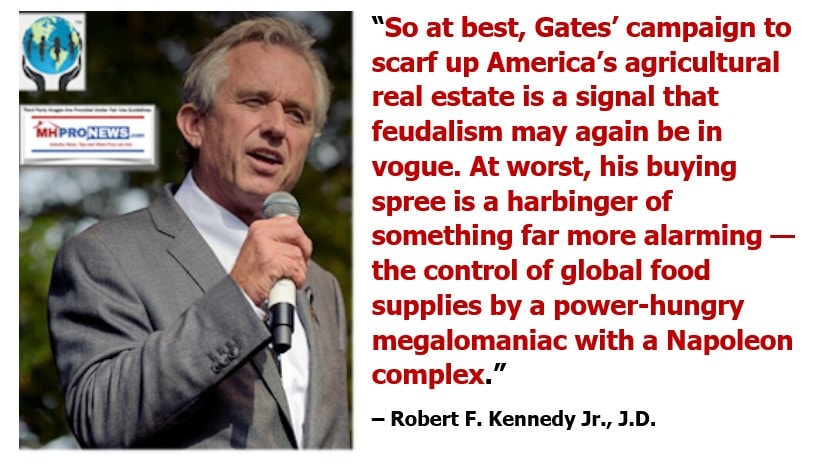
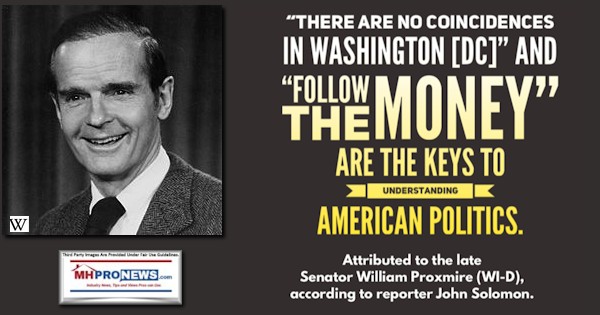
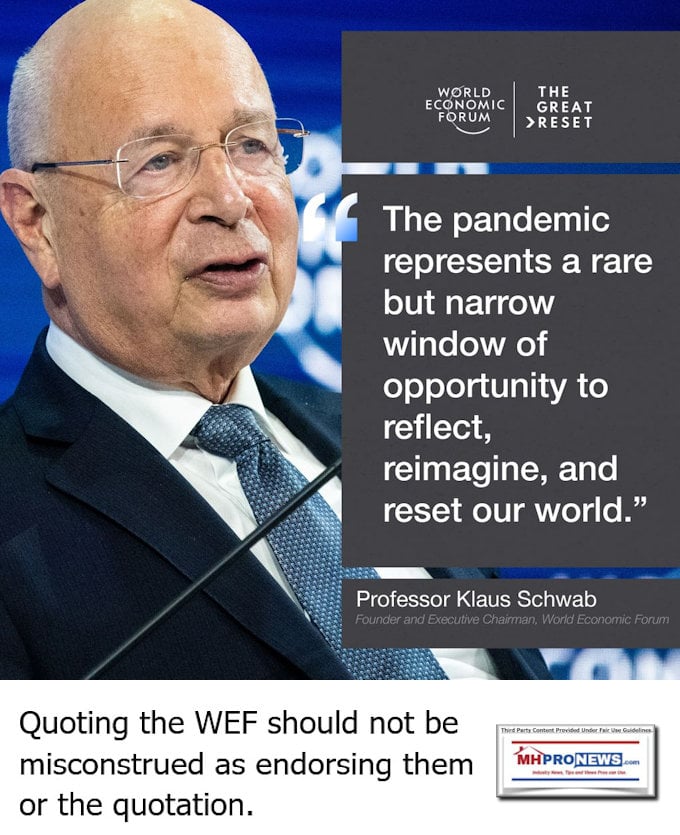
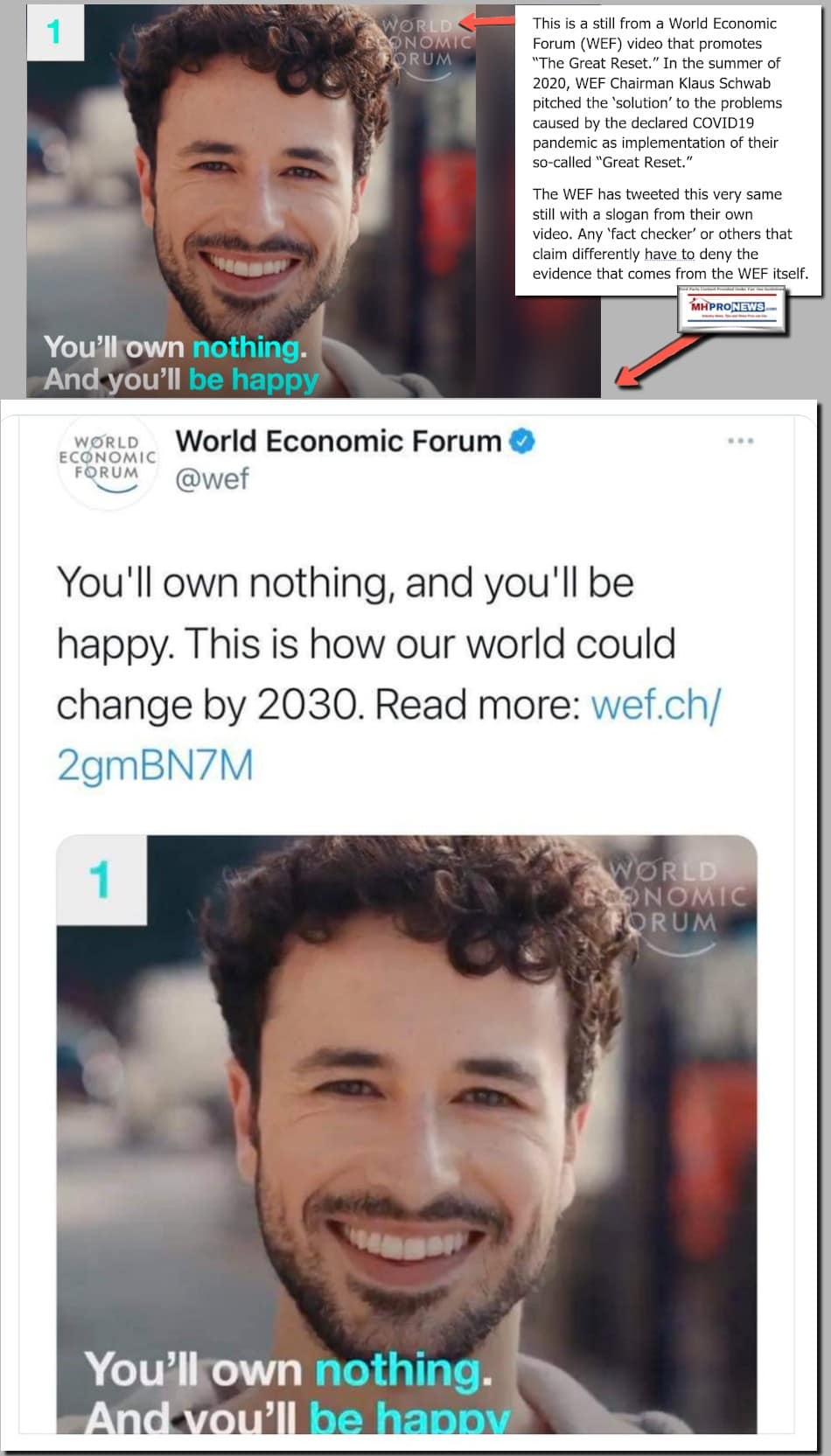


Summing Up
MHI itself acknowledged, as MHProNews previously reported, that the Louisiana vs. Biden suit put a temporary halt to the then-advancing rule. MHI, per a document from one of their outside attorneys to MHProNews, pays to have our reports ‘monitored.’ They are in no position to claim ignorance of what is factually outlined above.
Nor has MHI denied a single one of Ghorbani’s fact-and-evidence laced details provided to MHProNews that made clear their role in bringing the industry to this potential hit in costs and production of all HUD Code homes, but particularly so on entry level homes that people of lower incomes depend upon.
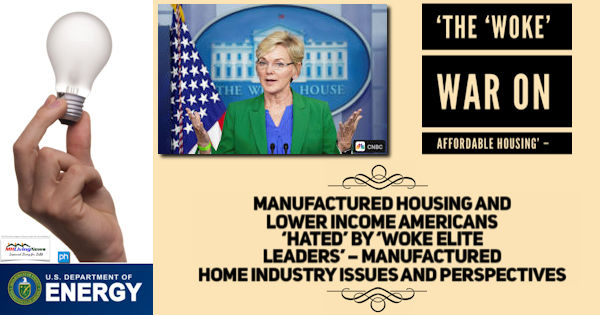
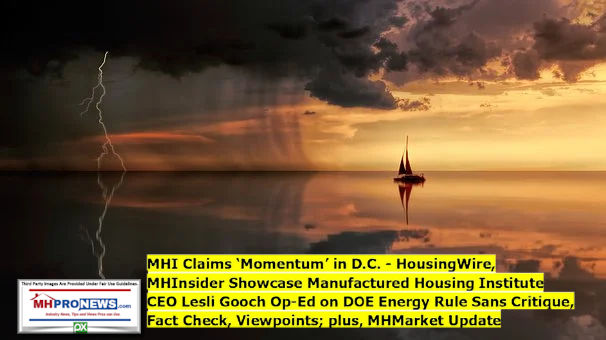
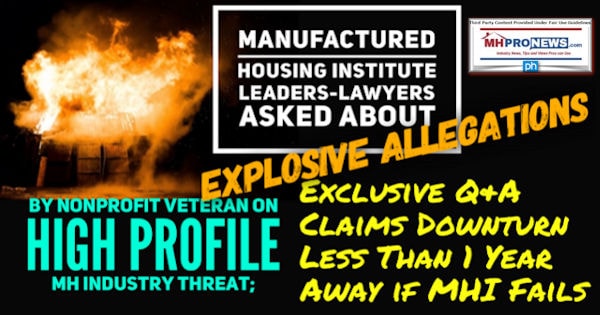
Through ‘friendly’ trade publications, bloggers, and other media sources, routinely complacent and compliant MHI ‘state affiliates,’ and MHI’s own emails to members, Berkshire-supported MHI has created a ‘narrative’ that MHI is ‘fighting’ the DOE.
- But if so, how can someone explain the facts about MHI’s role for years quietly or openly working with DOE as laid out by Ghorbani that prove otherwise?
- Furthermore, when the evidence clearly reflects that legal action has produced results, are trusting industry members simply going to believe that MHI doesn’t see the obvious need for legal action at this critical juncture?
The article by WND/RCE and Bryce have made it clear that there is a deep divide in America about the entire question of climate change and what the authentic agenda is being this push that has driven energy costs under Biden dramatically higher. While there are exceptions in both major parties, Republicans widely question the ‘green energy,’ while Democrats widely buy into the ‘climate’ change hysteria.
But even reliably left-leaning Michael Moore, producer of documentaries that routinely support Democrats and the left’s narratives, took part in a controversial video production that didn’t fit the ‘green energy’ narrative. Planet of the Humans cited example after example that made clear that green energy is costly and often doesn’t live up to is billing. It ironically made similar points to more conservative Prager U’s videos on the topic, both are posted below.
MHLivingNews published a report on the ‘Great Awakening.’ A growing number of Americans, faced with the harsh realities of the Democratic agenda vs. the pretty promises made before the 2020 election, are pushing back. Over a million new registrations of Republicans has occurred in a matter of months, a trend that is alarming Democratic strategists.
As Bryce in the article above pointed out, in Ohio, all the votes for strengthening local tools to fight so-called ‘green energy’ and the related land-grabs came from Republicans. All Democrats stood in opposition to that legislation. This comes down to a question of what is real and what is fake. As political independents, MHProNews’ management believes the truth can triumph over even clever and sustained big lies. What is certain is that there is an authentic debate over the issue of climate ‘change.’ The climate is always changing. It always has on planet earth.
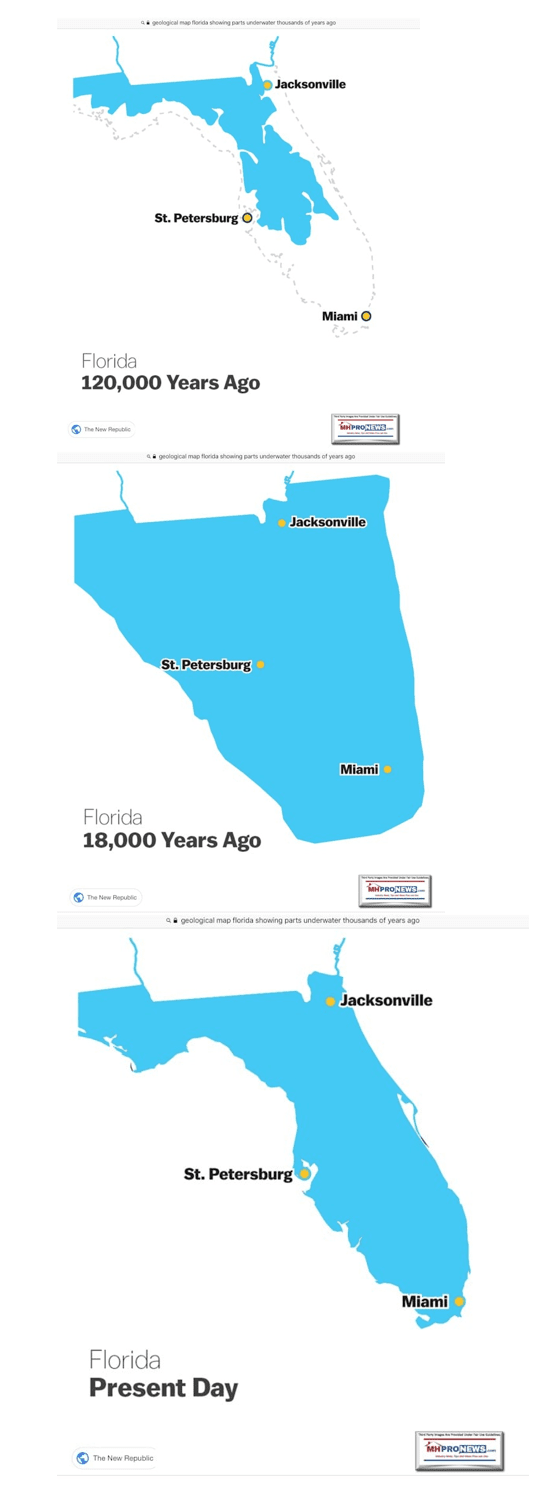

As the graphic above revealed, long before the industrial era and human produced CO2 emissions, sea levels and the climate were constantly shifting. While the billionaire backed PINO Biden regime is pushing climate change and cutting back on U.S. domestic oil production or access to Canadian energy via the Keystone XL Pipeline, other nations are opening more coal plants faster than the U.S. is replacing them. Meaning, while U.S. air may be ‘cleaner’ the CO2 emissions are still rising globally. America’s economy is being undermined in ways that benefits larger firms while harming smaller ones.
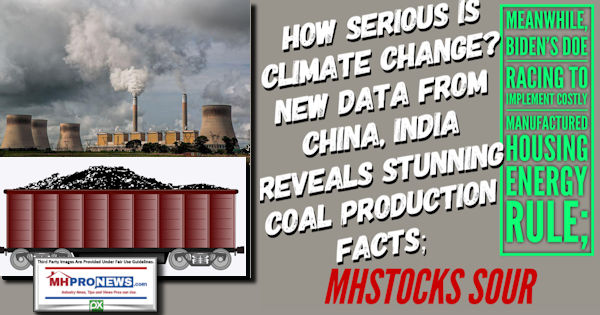
It is in the sense of these broader patterns that smaller manufactured housing firms must approach this climate/DOE and other issues. Since the early 21st century entry of Berkshire Hathaway owned brands began to emerge more directly into the manufactured housing profession, several realities have emerged. One is that the industry is smaller today than in 2002-2003. Yet Clayton Homes’ market share has grown. This appears to be a moat-method that fits concerns raised by monopoly investigator and antitrust advocate Schmitz and others like him of stealthy ‘sabotaging monopoly’ tactics.
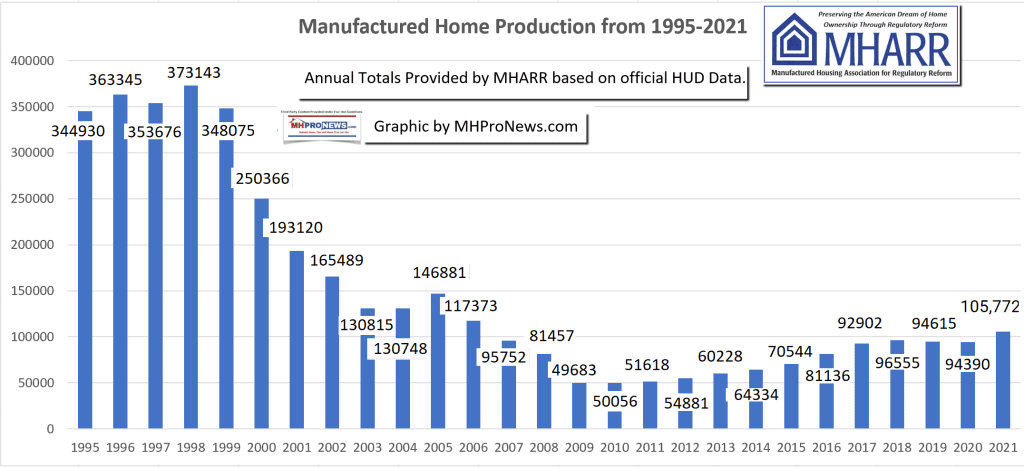
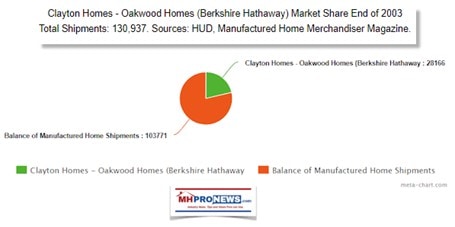
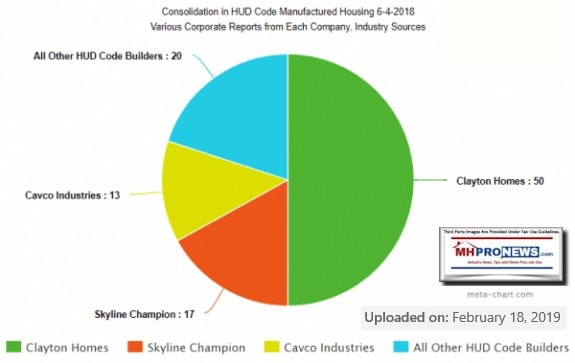
In conclusion, it should be clear that there are numerous examples of how legal action has been used by the political left, including companies and organizations in the Buffett-Berkshire orbit. While it is not the focus of this report, one must also keep in mind that Berkshire has broad conventional housing interests, including conventional real estate and site building. It is therefore not necessarily a concern for Berkshire if entry-level manufactured homes are harmed by the DOE energy rule for manufactured housing.
It is entirely understandable – even commendable – that MHARR and others are highlighting the problems connected with MHI.
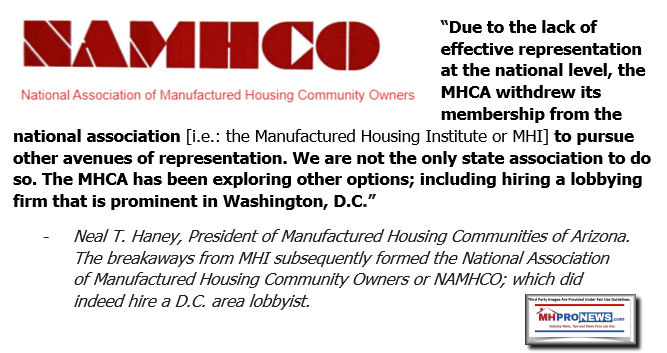
For those concerned about pushing back against giants like Buffett and Berkshire? “Berkshire itself is now down 25% from its March 31 high,” said Seeking Alpha on June 18, 2022. The small towns and communities Bryce reported in RCE or via WND above reveal that the small can push back against the giants. Several major brands that have ‘woke’ and leftist ties have lost significant share value in 2022 as the public increasingly turns their back on doing business with them.
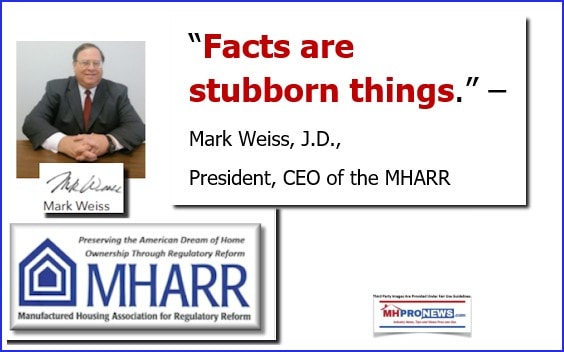
But such facts don’t necessarily mean that MHI is going to pivot, unless their corporate masters want them to. It is MHI board members, not CEO Lesli Gooch, who have the power at MHI. So long as the major brands de facto want headwinds for smaller firms, those headwinds from DOE’s looming rule implementation are likely to continue. It may take a lawsuit by current or former MHI members aimed at MHI board members for MHI to truly do what they claim they ‘want’ to do but have obviously failed at for well over a decade.

Stay tuned to MHProNews/MHLivingNews as these competing trends and forces manifest themselves. ##
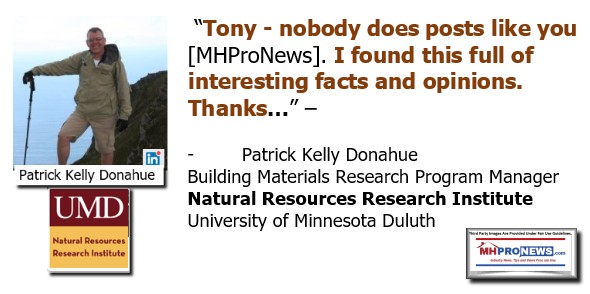
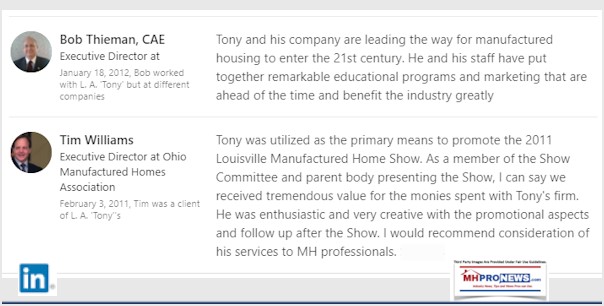
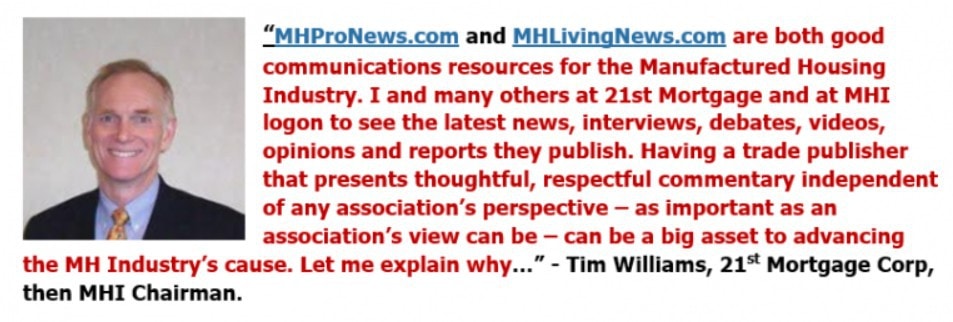
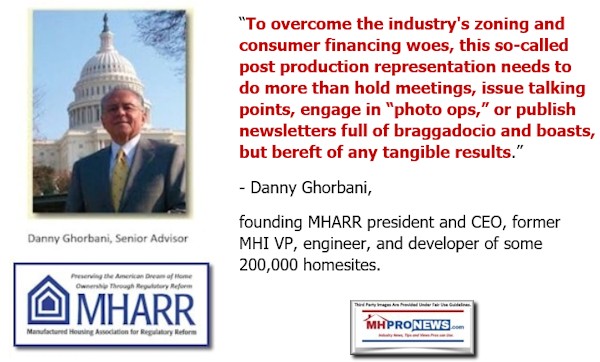


Again, our thanks to free email subscribers and all readers like you, our tipsters/sources, sponsors and God for making and keeping us the runaway number one source for authentic “News through the lens of manufactured homes and factory-built housing” © where “We Provide, You Decide.” © ## (Affordable housing, manufactured homes, reports, fact-checks, analysis, and commentary. Third-party images or content are provided under fair use guidelines for media.) (See Related Reports, further below. Text/image boxes often are hot-linked to other reports that can be access by clicking on them.)

By L.A. “Tony” Kovach – for MHProNews.com.
Tony earned a journalism scholarship and earned numerous awards in history and in manufactured housing.
For example, he earned the prestigious Lottinville Award in history from the University of Oklahoma, where he studied history and business management. He’s a managing member and co-founder of LifeStyle Factory Homes, LLC, the parent company to MHProNews, and MHLivingNews.com.
This article reflects the LLC’s and/or the writer’s position, and may or may not reflect the views of sponsors or supporters.
Connect on LinkedIn: http://www.linkedin.com/in/latonykovach
Related References:
The text/image boxes below are linked to other reports, which can be accessed by clicking on them.


